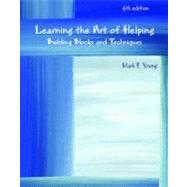
Note: Supplemental materials are not guaranteed with Rental or Used book purchases.
Purchase Benefits
What is included with this book?
| Helping as a Personal Journey | |
| The Demands of the Journey | |
| Becoming a Reflective Practitioner | |
| How a Helper Develops: Perry's Stages | |
| The Development of Expertise | |
| The Challenge of Development | |
| The Perfect Helper or When Do I Quit Developing? | |
| Who Can Be an Effective Helper? | |
| What Can You Bring to a Client? | |
| The Nuts and Bolts of Helping | |
| Defining Some Important Terms | |
| How is Professional Helping Different from Friendship? | |
| What Can You Expect from a Helping Relationship? | |
| Learning Basic Skills and Common Curative Factors | |
| Stages of the Helping Process: A Road Map | |
| The Therapeutic Relationship | |
| The Importance of the Therapeutic Relationship in Creating Change | |
| How Can a Helper Create a Therapeutic Relationship? | |
| Other Factors That Help or Strain the Therapeutic Relationship | |
| Helping Someone Who Is Different | |
| Differences That Can Affect the Therapeutic Alliance | |
| Challenges Caused by Differences in Culture | |
| Helping a Client Whose Culture is Different from the Helper's | |
| Challenges Caused by Differences in Gender | |
| Invitational Skills | |
| Listening to the Client's Story | |
| Nonverbal Communication Between Helper and Client | |
| Nonverbal Skills in the Helping Relationship | |
| Opening Skills: How to Invite | |
| Reflecting Skills: Paraphrasing | |
| Reflecting Content and Thoughts, Reflecting Feelings, and Reflecting Meaning | |
| Reasons for Reflecting | |
| The Skill of Paraphrasing: Reflecting Content and Thoughts | |
| Common Problems in Paraphrasing | |
| Reflecting Skills: Reflecting Feelings | |
| The Importance of Understanding Emotions | |
| The Skill of Reflecting Feelings | |
| How to Reflect Feelings | |
| Common Problems in Reflecting Feelings | |
| Reflecting Skills: Reflecting Meaning and Summarizing | |
| Meaning: Uncovering the Next Layer | |
| How to Identify Meaning Issues with a Clint | |
| Summarizing | |
| The Nonjudgmental Listening Cycle | |
| Challenging Skills | |
| When Should We Use the Challenging Skills? | |
| Giving Feedback | |
| How to Give Feedback | |
| Confrontation | |
| How to Confront | |
| Evaluating Confrontation and Client Response | |
| Assessment and the Initial Interview | |
| Table of Contents provided by Publisher. All Rights Reserved. |
The New copy of this book will include any supplemental materials advertised. Please check the title of the book to determine if it should include any access cards, study guides, lab manuals, CDs, etc.
The Used, Rental and eBook copies of this book are not guaranteed to include any supplemental materials. Typically, only the book itself is included. This is true even if the title states it includes any access cards, study guides, lab manuals, CDs, etc.